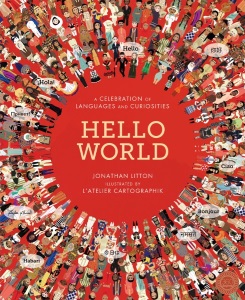2018 School Spending Survey Report

Find more great Horn Book content at these links:
Recommended books: reviews and themed booklists
App and e-book reviews
Movie reviews
Event news and recaps
Events calendar
Hello, hello
It really is a small world after all.
The Hello Atlas and Hello World: A Celebration of Languages and Curiosities are both large-format, fully illustrated atlases. Instead of details about capital cities and mountain ranges, each book presents facts about languages and the people who speak them. Despite their shared subject matter (and nearly identical titles and trim sizes!), each book approaches the topic in a different way.
 The Hello Atlas by Ben Handicott, illustrated by Kenard Pak (Wide Eyed/Quarto, December 2016) introduces named characters from around the world, speaking a total of over 100 languages, from Navajo to Malagasy. ("'Akaam. Akam Jituu? / Hello. How are you?' This is Meti. She speaks OROMO.") Childlike Mary Blair–style digital illustrations first identify languages within a wide region, then situate the characters in their own neighborhoods to highlight each individual child's language. I was especially charmed by the section on Antarctica, which explains how international communities have developed around research stations. In addition to facts about the languages' origins and relationships, the book thoughtfully covers colonialism and the loss of indigenous languages in a straightforward way that's appropriate for the recommended ages of 6 to 9. An appended section offers more handy phrases for each language. The book is accompanied by a free interactive app which allows readers to hear the pronunciation of greetings and introductory phrases.
The Hello Atlas by Ben Handicott, illustrated by Kenard Pak (Wide Eyed/Quarto, December 2016) introduces named characters from around the world, speaking a total of over 100 languages, from Navajo to Malagasy. ("'Akaam. Akam Jituu? / Hello. How are you?' This is Meti. She speaks OROMO.") Childlike Mary Blair–style digital illustrations first identify languages within a wide region, then situate the characters in their own neighborhoods to highlight each individual child's language. I was especially charmed by the section on Antarctica, which explains how international communities have developed around research stations. In addition to facts about the languages' origins and relationships, the book thoughtfully covers colonialism and the loss of indigenous languages in a straightforward way that's appropriate for the recommended ages of 6 to 9. An appended section offers more handy phrases for each language. The book is accompanied by a free interactive app which allows readers to hear the pronunciation of greetings and introductory phrases. Hello World: A Celebration of Languages and Curiosities by Jonathan Litton, illus. L'atelier Cartographik (360 Degrees/Tiger Tales, September 2016) encourages interactivity is a lower-tech way. The sturdy cardboard pages feature hundreds of tiny speech-bubble flaps that lift to reveal pronunciation guides. Although the lift-the-flap format suggests a younger audience, the book's content — and small print — align with the publisher's suggested 8 to 12 age range. The digitally created art is most notable for the detail in the minute figures (often, unfortunately, clothed in stereotypical garb). I do think it's important to note that while Hello World does include a closing warning that "a language is being lost every 14 days at the moment," it does not delve into the history or causes of that loss.
Hello World: A Celebration of Languages and Curiosities by Jonathan Litton, illus. L'atelier Cartographik (360 Degrees/Tiger Tales, September 2016) encourages interactivity is a lower-tech way. The sturdy cardboard pages feature hundreds of tiny speech-bubble flaps that lift to reveal pronunciation guides. Although the lift-the-flap format suggests a younger audience, the book's content — and small print — align with the publisher's suggested 8 to 12 age range. The digitally created art is most notable for the detail in the minute figures (often, unfortunately, clothed in stereotypical garb). I do think it's important to note that while Hello World does include a closing warning that "a language is being lost every 14 days at the moment," it does not delve into the history or causes of that loss.Ultimately, both of these atlases make strong introductions to world languages and geography for kids. As to why they are both being published this fall? Well, maybe it's a sign that we could all stand to improve our global awareness.
RELATED
RECOMMENDED
ALREADY A SUBSCRIBER? LOG IN
We are currently offering this content for free. Sign up now to activate your personal profile, where you can save articles for future viewing.






Add Comment :-
Be the first reader to comment.
Comment Policy:
Comment should not be empty !!!